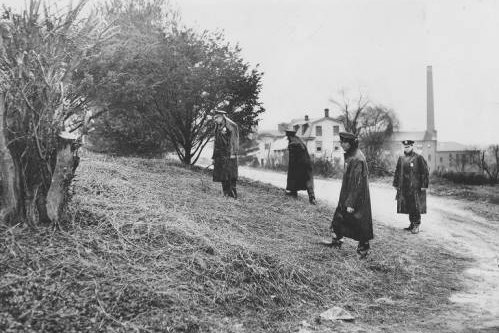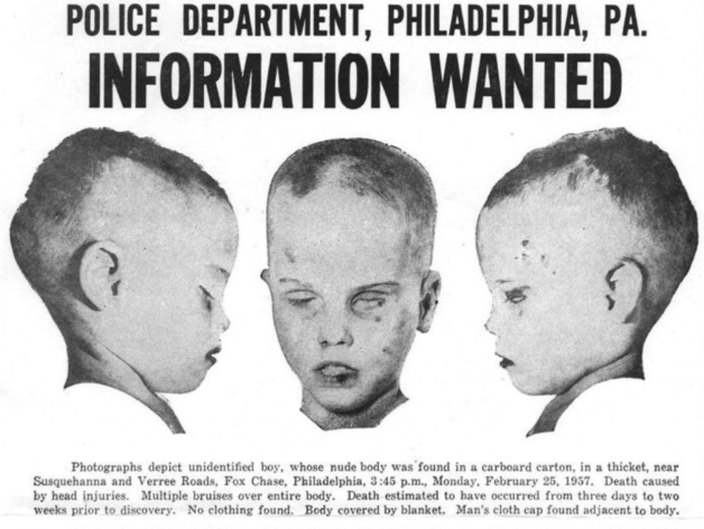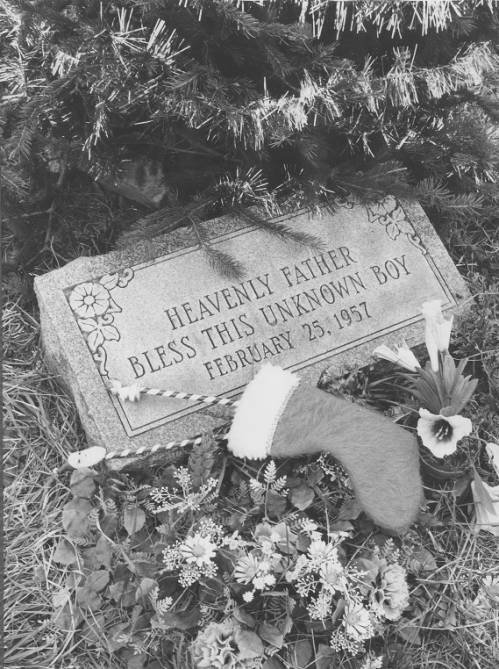
December 07, 2022
 Courtesy the Special Collections Research Center/Temple University Libraries
Courtesy the Special Collections Research Center/Temple University Libraries
In 1957, a young boy's body was found stuffed in a cardboard box in Northeast Philadelphia. Authorities will finally identify the 'Boy in the Box' on Thursday. In the photo above, police search for clues from the scene two days after the body was found.
The investigation into one of the nation's most gripping and disturbing murder mysteries will take a major step forward Thursday, when Philadelphia police reveal the identity of the notorious "Boy in the Box."
The decades-old cold case, which sent fear through the Northeast Philly community where the grisly discovery was made, finally got a big break thanks to ongoing detective work and DNA analysis, police said.
A press briefing will be held at 11 a.m. Thursday to identify the boy, who has long been referred to as "America's Unknown Child."
The case remains Philadelphia's oldest unsolved homicide, with a standing $20,000 reward for anyone who provides information leading to an arrest.
The case was detailed in an October 2020 episode of the podcast "Criminology," led by true crime researchers Mike Ferguson and Mike Morford. The episode examined the history of the case, from physical evidence gathered at the scene to witness statements, key suspects over the years and theories that still remain plausible.
On Feb. 25, 1957, the nude body of a young boy was found wrapped in a tattered blanket inside a cardboard J.C. Penney box. A La Salle College student told police he had first noticed the box two days earlier, while he was searching for rabbits in the area of Susquehanna Road, near Verree Road, in the Fox Chase section of Northeast Philly. The student said he had noticed muskrat traps that had been left unset by a teenager who lived nearby, so he decided to set them.
The student saw the box with the boy's head peeking out, but said he initially mistook it for a doll. It was only after he saw a newspaper story about a missing New Jersey girl that he returned to look inside the box and found the dead boy. That's when he called police, admitting to officers that he had actually been in the area to spy on girls at the Home of the Sisters of Good Shepard, a nearby residency for wayward youths.
Investigators determined that the box, which had the word "fragile" stamped on it, contained the body of a boy who appeared to be 4 to 6 years old. His arms had been carefully folded over his stomach and he had bruises on his face, arms, stomach and legs. Police believed the wrinkles found on the boy's palms and soles of his feet indicated that he had been immersed in water shortly before or after his death. Detectives took fingerprints from the boy's left hand.
An autopsy determined the boy had been killed by a severe blow to the head during a brutal attack, which seemingly happened in the two weeks prior to the box's discovery. The box had once contained a baby's bassinet and had a serial number tracing it to a J.C. Penney store in Upper Darby, about 15 miles from where the body was found.
The fair-skinned boy, with blond hair and blue eyes, weighed only about 30 pounds. Clumps of his hair were found with his body, leading detectives to believe his killer had shaved the hair down before disposing of the body. An analysis of the boy's remains indicated he had been malnourished, a finding that repeatedly guided detectives in their questioning of various suspects and witnesses over the years.
During the course of the investigation, more than 400,000 fliers were distributed across the city and the nation, asking for public assistance in the case. The search for the boy's killer became the most intensive homicide investigation attempted in Philadelphia at the time, involving hundreds of officers who searched a 12-square-mile area around where the body was found.
Thousands of copies of the poster above were distributed during the early stages of the 'Boy in the Box' investigation. It was prepared by the Philadelphia Inquirer as a public service, appearing in post offices, state liquor stores, racetracks and other places frequented by the public.
The early years of the investigation were marked by numerous tips that seemed promising, but were either disproven or failed to deliver definitive answers.
Upon hearing about the body, investigators initially believed the child might have been 4-year-old Mary Jane Barker, the girl the La Salle student had read about, who had gone missing around the same time in Bellmawr, New Jersey. She was found dead a few days later in the closet of a vacant room at a neighbor's home. She had died from dehydration and starvation after becoming trapped inside the room, authorities concluded.
A key piece of evidence came from a witness who had been driving along Verree Road two days prior to the boy's body being found. The man told police he had seen a middle-aged woman and a boy, who appeared to be 12-14 years old, unloading something from the trunk of a car; he thought they might have had a flat tire. When he asked them if they needed help, the woman and boy didn't say a word, but appeared to be purposely blocking the car's license plate. The encounter happened near where the body and some clothing had been found, but police were never able to definitively track down the woman or the boy.
The details of the man's account resurfaced in 2002, when an Ohio woman told police that she was the child that obstructed the license plate of the car. The woman, identified only as "M," claimed the boy in the box, named "Jonathan," was "purchased" from another family by her abusive mother in the summer of 1954. She said the boy had been physically and sexually abused at a home in Lower Merion in the years leading up to his death, according to AmericasUknownChild.net, a website and forum that compiles historical developments in the case.
"M" told investigators her mother had killed the boy in a fit of rage after he vomited baked beans in the home's bathtub one night. "M" said her mother had driven with her to the field to dispose of the body, leaving it in a large cardboard carton that they had found. "M" also claimed her mother had cut the boy's long hair in an effort to conceal his identity.
Philadelphia investigators interviewed "M" at her psychiatrist's office in Cincinnati. "M" claimed she had revealed the information to her psychiatrist in 1989, but waited 13 years before speaking with authorities. Detectives believed the account from "M" could be plausible, but questions surrounding her mental health made them skeptical of her story. Authorities were unable to substantiate any of the claims she made, including during a visit to the property in Lower Merion.
The initial stages of the investigation led authorities to a number of compelling possibilities, but they largely turned out to be dead ends.
Among the witness testimony examined in the "Criminology" podcast, one local barber told police he believed he had cut the boy's hair within a week before the body was discovered. The barber said the boy had told him he had lived with five brothers and a sister in the Strawberry Mansion section of the city, but investigators were never able to track that family down.
Another tip came from Camden, where a night manager at a restaurant claimed to have seen the boy at the business on two occasions in February 1957. The woman said the boy was with a man in his 40s, who had used the restaurant's phone to let the boy speak to his mother in Baltimore. When police checked the phone records, they found no evidence of the call. The father and son later were determined to have been another pair that had been reported missing, but were eventually found.
About two weeks after the boy's body was found, investigators tracked down the teenager who had placed the muskrat traps in the field where the box was discovered. The teen, who lived nearby, told police he had spotted the box within 48 hours of its discovery by the La Salle College student. The teen said he had seen the boy in the box while riding his bike in the area, became frightened and returned home without mentioning it to anyone. The teen's parents were unable to provide much help to detectives because they were Polish immigrants who didn't speak fluent English.
Based on the evidence from the scene and the absence of a missing persons report that would have corresponded to the boy's disappearance, police did not believe the boy had been kidnapped prior to his death.
In the early 1960s, police pursued other promising leads, including the case of a Colorado woman who had been accused of dumping her 3-year-old daughter's body in a trash can. The woman had matched a description of a person seen in the area of Fox Chase around the time of the boy's discovery, and was believed to have had family in the Philadelphia area. Authorities also looked into a carnival family that had traveled much of the eastern U.S., including Pennsylvania, and been implicated in other child abuse cases.
A Christmas stocking lies on the original tombstone marking the unknown boy at a city cemetery at Dunks Ferry and Mechanicsville roads, on Dec. 29, 1974. The boy's remains were later moved to Ivy Hill Cemetery in Cedarbrook.
The "Boy in the Box" investigation got renewed national attention when it was featured in a 1998 episode of "America's Most Wanted," leading to about 60 tips. Police and private investigators followed up, but did not learn anything conclusive. The episode aired again in 2008, keeping interest and momentum in the case alive. The first airing is what inspired the creation of the AmericasUknownChild.net website, which has been maintained by devoted followers of the case.
One standing theory suggests that the boy came from a foster home about 1.5 miles from the field where the box was found. The late Remington Bristow, a former employee at the Philadelphia Medical Examiner's Office and an avid follower of the case, once visited a psychic in New Jersey whose reading led him to the former foster home property. When Bristow attended an estate sale there, he found a bassinet similar to the one sold at J.C. Penney and blankets that looked like the one used to wrap the boy.
Philadelphia police pursued Bristow's leads and interviewed surviving family members connected to the foster home, clearing them of any involvement in the boy's death.
Over the years, the case has benefitted from the assistance of the Vidocq Society, a Philadelphia-based team of former detectives and forensics experts who pursue evidence in cold case investigations.
The boy's body was originally buried in July 1957 in a potter's field near Mechanicsville and Dunks Ferry roads in Northeast Philly. The headstone read, "Heavenly Father, Bless This Unknown Boy." The boy's remains were exhumed in 1998 to extract DNA, and he was interred again at a plot donated by Ivy Hill Cemetery in Cedarbrook. The new headstone bears the words, "America's Unkown Child" and has a carving of a lamb on it.
The boy was exhumed again in 2019 to pursue further DNA analysis.
Past attempts to identify the boy using DNA evidence and artists' sketches did not turn up any matches, including a possible lead that surfaced in 2016 and linked the boy to a family in Memphis. That lead was presented to Philadelphia police and the Vidocq Society, who concluded that there was no connection to the boy in the box.
In the "Criminology" podcast, Ferguson and Morford noted that the odds of obtaining an identity from the boy's DNA appeared to be slim due to the age of the samples. In recent years, however, major strides in forensic genetic genealogy have led to breakthroughs in numerous cold cases.
Philadelphia police said the DNA analysis leading to the identity of the boy in the box was performed by Identifinders International, a California-based team that works on difficult cases worldwide.
"Our expertise in forensic genetic genealogy is complemented by its experience with both Microarray and Whole Genome Sequencing (WGS) pipelines for processing even the most challenging DNA samples," the group's website says. "What truly makes Identifinders different is our versatility and personal attention to the cases that we investigate. Not just a vendor, we are investigative partners – collaborating with our law enforcement clients until the case is solved."
Identifinders International has been nationally recognized for its work solving the 1991 homicide of 16-year-old Sarah Yarborough in Washington and the 1992-1993 Phoenix canal killings, which involved two women who disappeared during bike rides and were later found dead in the same vicinity.
Thursday's press conference at PPD headquarters will be attended by Police Commissioner Danielle Outlaw; Captain Jason Smith, commanding officer of the Homicide Unit; Medical Examiner Dr. Constance DiAngelo; Ryan Gallagher, assistant director of the Philadelphia Office of Forensic Science; Colleen Fitzpatrick, a genealogist from Indentifinders International; and William C. Fleisher of the Vidocq Society.
 Source/Public Domain
Source/Public Domain Courtesy the Special Collections Research Center/Temple University Libraries
Courtesy the Special Collections Research Center/Temple University Libraries